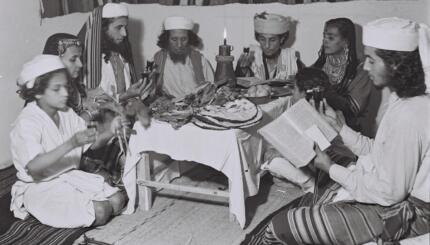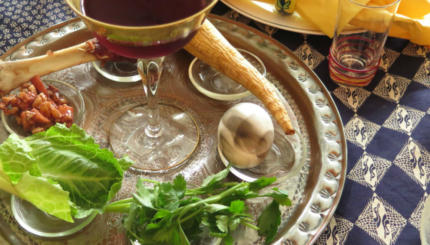It’s rare to hear people say, when commenting on a blessing in their lives, “It’s enough.” When it comes to goodness, we are greedy. We want an abundance of happiness, and sometimes think of it as our due.
But immediately after we tell of the exodus from Egypt in the Hagaddah, we break into a 15-stanza song where we sing jubilantly and in unison, Dayenu – It is enough.
Even those who rush through the seder spend time on this song, luxuriating in its central refrain. Should we sing the chorus after each stanza or wait? It depends on the family ritual. Yet, when we get to the last stanza, we find ourselves holding the last note.
Tightly constructed, Dayenu dates from the early medieval period. It is included in Seder Rav Amram, a prayer book created by Amram Gaon in the ninth century, though we do not know if Amram wrote the song or whether it was customarily recited in the Babylonia of his day.

Help us keep Jewish knowledge accessible to millions of people around the world.
Your donation to My Jewish Learning fuels endless journeys of Jewish discovery. With your help, My Jewish Learning can continue to provide nonstop opportunities for learning, connection and growth.
The 15 stanzas may mimic the 15 psalms, or songs of ascent, that were sung on the 15 steps of the ancient Temple. The song, just like the psalms, climb in holiness and significance.
Dayenu’s first five stanzas have to do with leaving Egypt, thus its placement right after the retelling of the Exodus. The first one thanks God for freeing us, while the remainder look back to other features of the experience. We might have expected each stanza to praise a separate plague or have a line that speaks of all them cumulatively, but only one plague is mentioned: the death of the firstborn Egyptians. It is only this most awful plague that signaled a real step toward freedom. The other three stanzas sing of the redress of justice necessary for us to feel truly thankful.
The next five stanzas focus on the wilderness experience and the unique miracles that God wrought for the Israelites during this transitional time. The first three concern the parting of the Sea of Reeds — first the sea split, then God escorted us through to dry land, and only then were the Egyptian pursuers drowned in the chase. This event was so seminal that we pause and speak of it in detail and sing for each blessed facet of its salvific power. We then thank God for manna, heaven’s bread, and offer gratitude that God took care of our needs for those hard, long 40 years.
As we ascend in holiness, we turn away from historical events and miracles to the staples of spiritual life that are foundational to Judaism. The final five stanzas express gratitude for Shabbat, Sinai, the Torah, Israel and the Temple. Each represents different portals of Jewish expression: rest, revelation, knowledge, homeland, and prayer. Just as we sing “Next Year in Jerusalem” when we remain terribly far from that reality, we conclude Dayenu with the Temple because our work is not yet done.
Many commentators have observed that it would actually not have been enough if we had the manna but not Shabbat or the Torah or the Land of Israel. Judaism would be incomplete. But this perspective is exactly the opposite of the sentiment the song is meant to conjure.
As the scholar Dr. Solomon Schimmel has written, “One interpretation of the structure of this poem is that when we reflect on a benefit that G-d (or by extension, another person) has done for us, we should break it into its multiple components, meditating on each element.”
Dayenu begins with an experience we had just been through, the exodus, and uses it to wax lyrical on a host of other experiences, asking us to see the interconnectedness of our blessings. It invites us to break each gift into its multiple components and then put them back together and stare in disbelief at our good fortune: I am grateful for this and for this and for this — until we become saturated with the unfolding of our prosperity and can think only of God’s myriad kindnesses.
The writer Melody Beattie beautifully captures what Dayenu is really saying and what all deep gratitude looks like: “Gratitude unlocks the fullness of life. It turns what we have into enough, and more.”
We don’t realize how lucky we are until we speak our blessings in detail. Dayenu is not merely a reflection on Passover, but a template for true thanks.
Imagine for a moment a thank-you note where instead of the usual clichés you had a note in the form of Dayenu, outlining several details of appreciation. Had the person done only one it would have been enough.
Now imagine receiving such a note — highly personal, thoughtful and unique. It might the thank-you note you actually save.
Dayenu suggests this very formula when thanking God. It is our detailed thank-you note to God — not only for saving us from the terrors of Egypt, but for giving us the instruments and experiences to form a life of Jewish meaning. It’s a wonder that we don’t recite it every day. But at our seder tables, we might take a moment after this jubilant song to turn to those at the table and, in detail, describe how blessed we are in their presence.
Dr. Erica Brown is an associate professor at George Washington University’s Graduate School of Education and Human Development and the director of its Mayberg Center for Jewish Education and Leadership. She is the author of “Seder Talk: A Conversational Haggadah.”



